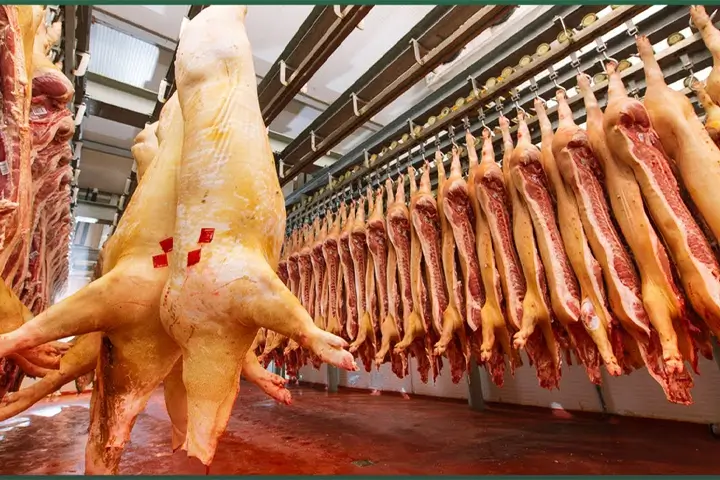
Namibia’s meat industry faced an interesting challenge during the second quarter (Q2) of 2023 as it had to resort to importing a significant portion of its pork requirements. The Meat Board of Namibia reported that despite slaughtering 11,363 pigs during this period, the country could only produce 1,108 tonnes of pork, covering just 40.4% of the local fresh pork consumption demands. As a result, Namibia imported 1,631 tonnes of fresh and processed pork to bridge the gap and meet the remaining 60% of its pork needs.
The situation is particularly unfortunate given the ongoing ban on the importation of pork from South Africa, which had been one of the major sources of pork for Namibia in the past. However, the report suggests that there is hope for the future, as local pork production is expected to increase, aiming to counterbalance the shortfall and reduce reliance on imports.
Analyzing the pork import data, the report indicates that of the total volumes of pork imports, 61.7% consisted of pork offal, while pork cuts and cooked pork and uncooked processed pork accounted for 26.7% and 11.6%, respectively. This information highlights the specific types of pork products that Namibia had to import to meet its domestic demands.
Despite the pork challenges, the livestock and meat industry, in general, showed signs of improvement during the second quarter of 2023. Both cattle and sheep sectors recorded better slaughtering rates, which were aided by favorable producer prices. The marketing activities in A-class abattoirs for cattle and sheep drove overall improvements in total marketing for these sectors.
The cattle sector observed a noteworthy growth of 8% in cattle marketing compared to the same quarter in 2022. In total, 78,212 cattle were marketed during Q2 of 2023, indicating positive momentum in this segment. Meanwhile, the sheep sector experienced a remarkable 17.9% consecutive growth rate, with 276,325 sheep marketed, compared to 234,354 in 2022. This increase was primarily fueled by sustained growth in live sheep exports and higher slaughtering rates at export-approved abattoirs.
One interesting aspect is the shift in the ratio between live exports and slaughtering in the country. Currently, 53% of all cattle marketed were slaughtered at A, B, and C class abattoirs, whereas live exports’ market share reduced and averaged 47.0%, a decline of 5.9% compared to total marketing. This indicates a changing landscape in the industry, with more focus on domestic processing and consumption.
On a positive note, beef imports have seen a significant decline of 52.4% from the previous year, with only 260 tonnes imported during 2023 compared to 547 tonnes in 2022. Export-approved abattoirs have played a crucial role in increasing beef supply to the domestic market, leading to reduced volumes of beef imports, particularly offal products. The improved beef trade balance of 4,799 tons in 2023 is a testament to the country’s increased beef production and export efforts.
Similarly, the sheep sector’s export performance has been impressive, with a growth rate of 141.4% in slaughtering at export-approved establishments compared to moderate levels recorded in 2022. This translated to a substantial increase in mutton exports, which nearly doubled during the quarter. However, there were some mutton imports (53 tonnes) in the form of offal during the same period.
Market signals in the livestock and meat industry seem to be functioning well, as producers responded positively to relatively attractive prices offered by A-class abattoirs. B2 producer prices paid by export-approved abattoirs south of the veterinary cordon fence (sVCF) experienced a slight increase from N$60.77/kg to N$61.06/kg, signaling a healthy market environment.
Despite these encouraging signs, the weaner prices struggled to recover during Q2 of 2023. The average weaner price declined by 31.7% compared to the previous year, mainly due to reduced demand for Namibian weaners by South Africa. South African weaners, in contrast, were faring better in the market. The Weaner/B2 producer price ratio also declined to 40.9%, below the ideal 64% benchmark, further impacting the industry’s balance among market segments.
In terms of goat farming, the total marketing of goats increased by 4.6%, with 37,178 goats marketed during Q2 of 2023 compared to 35,538 in the same period last year. However, goat slaughtering experienced a significant decrease of 76.85%, affecting the overall marketing figures. The positive trend in live goat exports was the primary driver behind the overall increase in goat marketing.
Despite the overall growth in the goat sector, goat lamb prices at auctions decreased by N$7.67/kg compared to 2022, averaging N$32.06/kg in Q2 of 2023. This decline could be attributed to various market dynamics and demand factors.
In conclusion, Namibia’s meat industry faced challenges with pork production during Q2 of 2023, leading to a substantial reliance on pork imports to meet domestic demand. However, the livestock and meat industry, as a whole, showed signs of improvement, with increased cattle and sheep marketing. Beef exports and mutton exports also saw positive growth trends, contributing to a better trade balance. Moving forward, efforts to increase local pork production and maintain a balanced market among different segments will be crucial for the industry’s sustainable growth and self-sufficiency.
Stay updated with the latest farming tips and agriculture industry news from Africa by subscribing to our newsletter. Don’t miss out on valuable insights and updates. Follow us on Twitter, LinkedIn, and Facebook to join our farming community and stay connected with us.



















